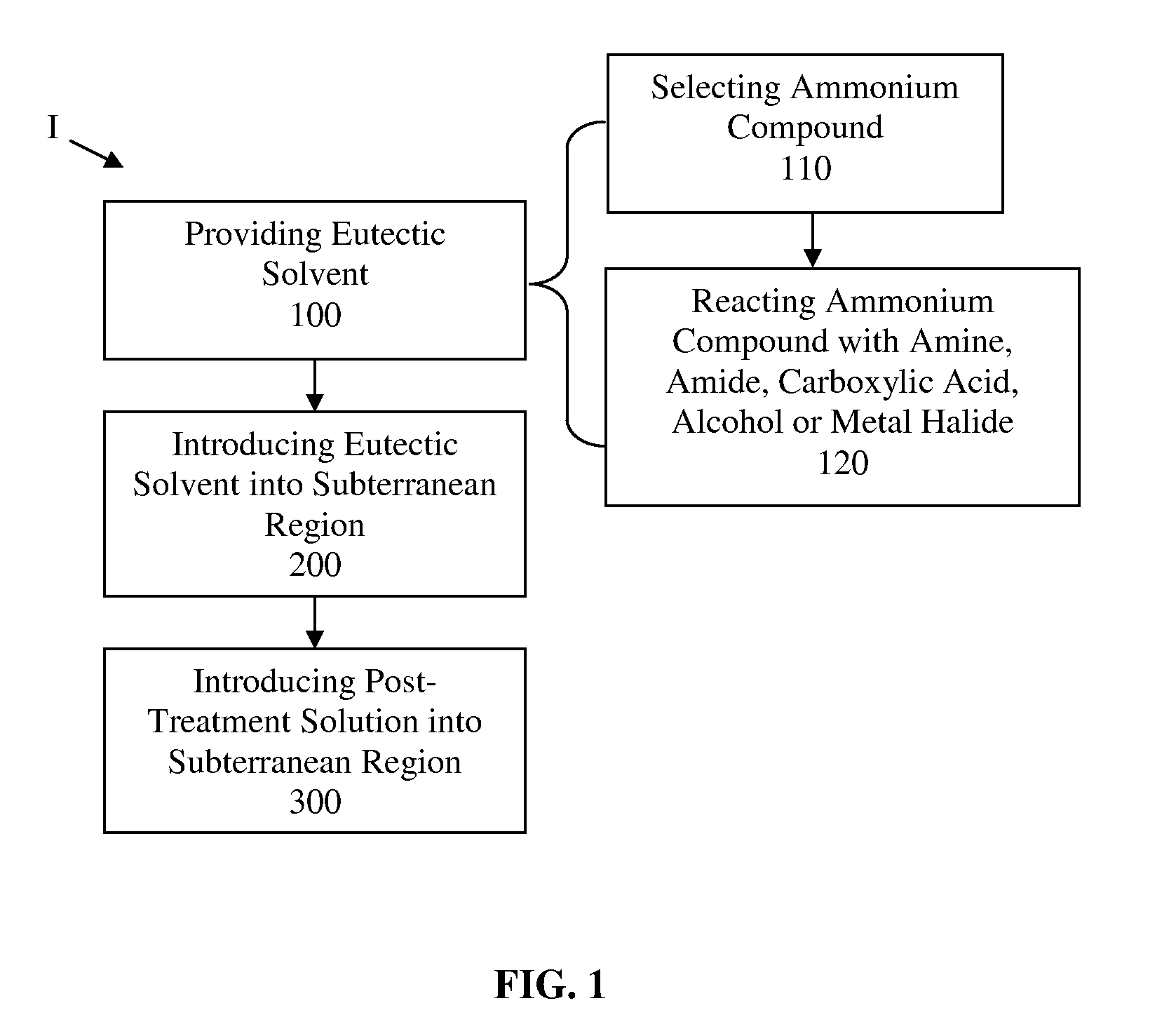Deep eutectic solvents and applications
a technology of deep eutectic solvents and solvents, applied in the direction of fluid removal, chemistry apparatus and processes, borehole/well accessories, etc., can solve the problem of chemically modified cellulosic materials
- Summary
- Abstract
- Description
- Claims
- Application Information
AI Technical Summary
Problems solved by technology
Method used
Image
Examples
example 1
Synthesis of Choline Chloride / Amide Deep Eutectic Solvent (DES)
[0052]Urea which has a melting point of 133° C. (271° F.) is combined with N-(2-hydroxyethyl) trimethyl-ammonium chloride (choline chloride) which has a melting point of 302° C. (575° F.) in a 2:1 molar ratio. One (1) mole (139.6 grams) of choline chloride, [N-(2-hydroxyethyl)trimethylammonium chloride, (CH3)3N+CH2CH2OH] Cl−, FW=139.6 g / mol] is employed as a dry powder or flake and is added to 2 moles of urea, an amide, [120 grams [(NH2)2CO, FW=60 g / mol]. With stirring, the dry mixture is heated to 100° C. (212° F.) until the solids have all been dissolved to affect reaction and remove any latent water in either component. The reaction is continued until a clear, viscous, uniform solution is formed. If an exotherm is observed, external heating is discontinued until the exotherm subsides. If the reaction solution is still not completely clear and uniform, the reaction mixture may again be heated externally to 100° C. (212...
example 2
Synthesis of Chlorcholine Chloride / Amide Deep Eutectic Mixtures (DES)
[0054]Chlorcholine chloride [Cl−(CH3)3N+CH2CH2Cl), 12.96 g, 0.082 mol) is added to urea (9.78 g., 0.163 mol) and the mixture heated to 80° C. (176° F.) with stirring for approximately 30 minutes. A clear, viscous, uniform solution is formed and allowed to cool to room temperature at a rate of approximately 1° C. / min. The liquid can be maintained for at least a month when protected against moisture.
[0055]As with choline chloride in Example 1, numerous chlorcholine chloride / amide derivatives can be prepared. The reaction time is reduced due to the higher reactivity coefficient of the chloro-derivative.
example 3
Synthesis of Choline Chloride / Carboxylic Acid Deep Eutectic Mixtures (DES)
[0056]Based on the method presented in Example 1, it becomes apparent that a eutectic is formed at a composition of 67% mol urea. From this data, it can be inferred that to form the eutectic two carboxylic acid molecules are required to complex each chloride ion. Therefore, a mono-functional carboxylic acid molecule reacts with ChCl− on a 1:2 molar basis as is the case with phenylpropionic acid (C6H6CH2CH2CO2H) and phenylacetic acid (C6H6CH2CO2H).
[0057]Eutectics formed with di-functional carboxylic acids occur at a 50% mol ratio strongly suggesting a 1:1 complex between the acid and the chloride ion or else said acids act as bridging molecules between neighboring chloride ions. Such would be the case when considering oxalic acid (HO2CCO2H), malonic acid (HO2CCH2CO2H) and succinic acid (HO2CCH2CH2CO2H), for examples.
[0058]The freezing point depression, when compared to an ideal mixture of the two components, fo...
PUM
| Property | Measurement | Unit |
|---|---|---|
| wt % | aaaaa | aaaaa |
| temperature | aaaaa | aaaaa |
| temperature | aaaaa | aaaaa |
Abstract
Description
Claims
Application Information
 Login to View More
Login to View More - R&D
- Intellectual Property
- Life Sciences
- Materials
- Tech Scout
- Unparalleled Data Quality
- Higher Quality Content
- 60% Fewer Hallucinations
Browse by: Latest US Patents, China's latest patents, Technical Efficacy Thesaurus, Application Domain, Technology Topic, Popular Technical Reports.
© 2025 PatSnap. All rights reserved.Legal|Privacy policy|Modern Slavery Act Transparency Statement|Sitemap|About US| Contact US: help@patsnap.com

